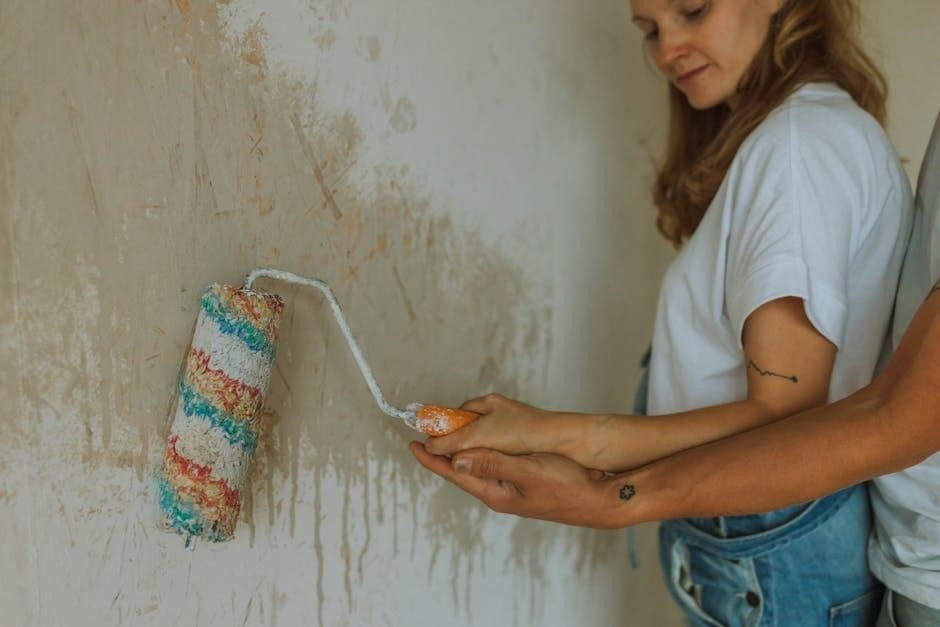Paint transforms and protects surfaces, enhancing both interior and exterior spaces with color, texture, and durability. It combines aesthetics with functionality, making it an essential tool for any project.
What is Paint and Its Primary Functions
Paint is a liquid mixture designed to form a protective or decorative coating on surfaces when dried. It consists of pigments, binders, and solvents, which work together to create a durable and aesthetically pleasing finish. Paint serves multiple functions, including enhancing appearance, protecting surfaces from wear and tear, and providing functionality, such as light reflection or antimicrobial properties. It is applied to various materials like wood, metal, and walls to achieve desired results. Paint also plays a role in preserving surfaces from environmental factors like moisture and UV exposure. Whether for artistic purposes or industrial applications, paint is an essential tool for transforming and safeguarding surfaces effectively.
Importance of Choosing the Right Paint Type
Selecting the right paint type is crucial for achieving desired results and ensuring long-lasting performance. Different surfaces, such as wood, metal, or drywall, require specific paint formulations to enhance durability and adhesion. Choosing the wrong paint can lead to premature wear, peeling, or fading, wasting time and resources. Paints designed for exterior use offer weather resistance, while interior paints focus on aesthetics and ease of cleaning. Additionally, considering factors like moisture exposure or heavy traffic helps in picking paints with the right finish and protective properties. The right paint ensures a professional finish and maintains the integrity of your project for years to come.

Types of Paint
Paints vary widely, with options like water-based, oil-based, acrylic, and latex. Each type serves specific purposes, ensuring durability, aesthetics, or surface protection based on application needs.
Water-Based Paints
Water-based paints, also known as latex paints, are the most commonly used option for interior and exterior projects. They are low in odor, dry quickly, and clean up easily with water. These paints are versatile and suitable for surfaces like walls, ceilings, and wood. They are environmentally friendly and offer excellent durability and resistance to wear; Water-based paints are ideal for high-traffic areas and exterior surfaces due to their weather-resistant properties. They come in various finishes, from flat to high-gloss, catering to different aesthetic preferences. For best results, a primer is often recommended to ensure proper adhesion and a smooth finish. This type of paint is a popular choice for DIY projects and professional applications alike.
Oil-Based Paints
Oil-based paints, also known as solvent-based paints, are renowned for their smooth finish and durability. They are ideal for surfaces like wood, metal, and trim due to their hard, glossy finish and excellent adhesion. Oil-based paints are resistant to wear and tear, making them suitable for high-traffic areas and exterior projects. However, they have a strong odor, take longer to dry, and require solvent-based cleanup. They are less flexible than water-based paints, which can lead to cracking over time. Despite these drawbacks, oil-based paints remain a popular choice for projects requiring a durable and long-lasting finish.
Latex Paints
Latex paints are water-based and versatile, making them a popular choice for both interior and exterior projects. They are known for their low odor, quick drying time, and easy cleanup with soap and water. Latex paints are flexible, resisting cracks as surfaces expand and contract, and are suitable for a wide range of surfaces, including walls, ceilings, and trim. They offer good durability and are resistant to fading and moisture. Available in various finishes, from flat to high-gloss, latex paints are eco-friendly and a practical option for most painting needs. Their fast-drying properties make them ideal for projects where time is a priority, and they are widely recommended for DIY and professional use alike.
Acrylic Paints
Acrylic paints are water-based and known for their versatility and durability. They are suitable for a wide range of surfaces, including wood, metal, and fabric, making them ideal for both indoor and outdoor projects. Acrylic paints dry quickly, often within 15-30 minutes, and form a flexible, water-resistant finish that resists fading, chipping, and cracking. They are available in a variety of vibrant colors and finishes, from flat to high-gloss, and can be easily mixed for custom shades. Their fast-drying properties and excellent adhesion make them a popular choice for DIY projects, furniture restoration, and artistic applications. Acrylic paints are also low in volatile organic compounds (VOCs), making them a more eco-friendly option for many users.
Enamel Paints
Enamel paints are known for their glossy finish and durability, making them ideal for surfaces that require a hard, protective coating. They are commonly used on metal, wood, and glass and are available in both oil-based and water-based formulas. Oil-based enamels dry slowly but offer superior durability, while water-based options dry quickly and are more eco-friendly. Enamel paints are resistant to wear, tear, and moisture, making them perfect for high-traffic areas and exterior projects. They are also easy to clean and maintain, retaining their vibrant colors and sheen over time. However, oil-based enamels can have strong fumes, so proper ventilation is essential during application. Their versatility and aesthetic appeal make them a popular choice for both functional and decorative purposes.
Spray Paints
Spray paints are versatile and easy to apply, offering a quick way to cover large or irregular surfaces. They are available in oil-based and water-based formulas, with oil-based options providing superior durability and water-based ones emitting fewer fumes. Spray paints are ideal for metal, wood, and plastic and are commonly used for crafts, furniture, and automotive projects. They dry rapidly, often within minutes, and come in a wide range of colors and finishes, including glossy, matte, and textured. However, spray paints can be messy and may require proper ventilation due to strong fumes. Their convenience and adaptability make them a favorite for DIY enthusiasts and professionals alike. Always use protective gear when applying spray paints for best results.
Specialty Paints
Specialty paints are designed for unique applications and offer specific benefits tailored to particular surfaces or needs. Examples include anti-corrosive paints for metal protection, textured paints for decorative effects, and metallic paints for a reflective finish. Some specialty paints are formulated for high-temperature environments, while others are eco-friendly or low-VOC for better indoor air quality. There are also glow-in-the-dark paints for safety or artistic purposes and magnetic paints for creating interactive surfaces. These paints often require special preparation and application techniques to achieve optimal results. Choosing the right specialty paint ensures long-lasting performance and meets the unique demands of your project. Always follow manufacturer guidelines for application and drying times.

Paint Finishes
Paint finishes range from flat to high-gloss, offering varying levels of sheen, durability, and light reflection. Each finish enhances aesthetics and protects surfaces, suited for different spaces and needs.
Flat (Matte) Finish
A flat (matte) finish is characterized by its non-reflective, dull appearance, offering minimal sheen. It is ideal for hiding surface imperfections and creating a subtle, understated look.
This finish is best suited for low-traffic areas, such as ceilings and interior walls, where durability is less of a concern. It is not highly resistant to wear or moisture, making it less practical for high-touch surfaces or areas prone to humidity.
Flat finishes are easy to apply and provide excellent coverage, making them a popular choice for achieving a smooth, uniform appearance without the glare of higher-sheen options.
Eggshell Finish
An eggshell finish offers a subtle, low-sheen appearance, slightly more reflective than flat (matte) finishes but still understated. It is more durable than flat finishes, making it suitable for low to moderate traffic areas.
This finish is ideal for hiding minor surface imperfections while providing a soft, elegant look. It is often used on walls, ceilings, and trim in residential settings due to its balance of aesthetics and practicality.
Eggshell finishes are resistant to scuffs and moisture, making them a good choice for areas like kitchens and bathrooms. They are also easy to clean, adding to their versatility and appeal for everyday use.
Satin Finish
A satin finish offers a soft, warm glow with a moderate sheen, making it a popular choice for interior walls. It is more durable than eggshell or flat finishes, making it ideal for high-traffic areas like hallways and family rooms.
This finish is resistant to moisture and wear, making it suitable for kitchens and bathrooms. Its subtle sheen hides minor imperfections while maintaining a clean, modern appearance. Satin finish is also versatile, working well in both traditional and contemporary settings. It provides a balanced look that is not too shiny but still offers enough light reflection for a polished feel. This finish is a great option for those seeking durability and aesthetics without the high gloss of semi-gloss paints.
Semi-Gloss Finish
A semi-gloss finish offers a bright, reflective appearance with a high sheen level, making it ideal for surfaces that require both durability and visual appeal. It is commonly used on trim, doors, windows, and cabinets due to its ability to withstand heavy wear and tear. The finish is highly resistant to moisture, making it a great choice for bathrooms and kitchens. Its reflective nature accentuates light, creating a modern and polished look. However, semi-gloss finishes can show more imperfections on the surface due to their high sheen. Regular cleaning is easy, as the smooth texture repels dirt and grime. For best results, ensure surfaces are properly prepared before application to achieve a flawless finish. This option strikes a balance between aesthetics and functionality, making it a versatile choice for various projects.
High-Gloss Finish
A high-gloss finish is the most reflective and shiny option, offering a mirror-like appearance that enhances light reflection. It is extremely durable and resistant to wear, making it ideal for high-traffic areas and surfaces that need maximum protection, such as doors, trim, and cabinets. The finish is easy to clean and stands up well to moisture, making it a popular choice for kitchens and bathrooms. However, its reflective nature highlights surface imperfections, so proper surface preparation is essential. High-gloss paint is also versatile and can be used on both interior and exterior surfaces. While it provides a bold, modern look, it is less commonly used on large wall areas due to its intense sheen. This finish is perfect for accentuating details and creating a polished, sophisticated aesthetic. Proper application ensures long-lasting results.

Application Tips and Techniques
Ensure smooth, even coverage by preparing surfaces properly. Use high-quality tools like rollers or brushes for best results. Apply thin coats, allowing each to dry before recoating.
Preparing Surfaces for Painting
A well-prepared surface is key to a successful painting project. Start by cleaning the area with soap and water to remove dirt, grease, or wax. For rough surfaces, light sanding ensures better paint adhesion. Fill cracks or holes with spackling compound and sand smooth. Remove old, peeling paint and dust thoroughly. For bare wood or metal, apply a primer first. Allow all surfaces to dry completely before painting. Proper preparation prevents peeling and ensures a smooth, professional finish.

Tools and Equipment Needed
Having the right tools ensures a smooth painting process. Start with high-quality paintbrushes in various sizes for detailed work. Roller brushes and extension poles are ideal for large, flat areas like walls and ceilings. Use a paint tray or roller pan to hold and load paint. Protect surfaces with drop cloths or tarps. For edges and corners, try a paint edger or masking tape. Sandpaper or a sander is essential for smoothing surfaces. A ladder or step stool provides safe access to high areas. Don’t forget protective gear like gloves, goggles, and a mask. Optional tools include a paint sprayer for quick coverage. Investing in the right equipment ensures professional results and efficiency.
Best Practices for Applying Paint
For a professional finish, always prepare surfaces by cleaning, sanding, and filling cracks. Use a primer for uneven or dark colors. Apply paint in thin, even layers, allowing each coat to dry fully. Work in small sections to maintain even coverage. Avoid painting in direct sunlight or high humidity. Use light strokes to prevent drips and unevenness. Test color samples first. Remove outlet covers and light switches for a clean look. Keep a wet edge when rolling to prevent lines; Allow the final coat to cure fully before touching. Clean tools with soap and water or solvent. Store leftovers properly. Follow safety guidelines, especially with oil-based paints.

Choosing the Right Paint for Your Project
Selecting paint involves considering surface type, durability, and aesthetics. Evaluate factors like finish, color retention, and moisture resistance to ensure the best fit for your needs. Always check environmental and safety guidelines to make an informed choice.
Factors to Consider: Surface, Durability, and Aesthetics
When selecting paint, it’s crucial to consider the surface type to ensure proper adhesion and longevity. Different paints are formulated for specific materials like wood, metal, or drywall. Durability is another key factor, as high-traffic areas or outdoor surfaces require paint with superior resistance to wear, moisture, and fading. Aesthetics play a significant role, with color and finish impacting the overall look and feel of a space. Additionally, consider environmental and safety aspects, such as VOC levels and eco-friendly options. By evaluating these factors, you can choose paint that meets both functional and visual needs, ensuring a successful and long-lasting result for your project.
Environmental and Safety Considerations
When selecting paint, consider its environmental impact and safety aspects. Many paints contain volatile organic compounds (VOCs), which can harm indoor air quality and the environment. Opting for low-VOC or eco-friendly paints, such as water-based or natural options, reduces emissions and promotes sustainability. Always read labels for certifications like Greenguard Gold to ensure compliance with environmental standards. Safety precautions, such as wearing gloves and masks during application, are essential to protect against fumes and skin irritation. Proper ventilation is also critical to minimize inhalation risks. Finally, dispose of leftover paint and materials responsibly, following local regulations to prevent environmental contamination. Balancing performance and eco-consciousness ensures a healthier space for both people and the planet.
Paint selection and application are crucial for achieving desired results. Explore resources like Asian Paints and Sherwin-Williams guides for detailed tips and inspiration to enhance your projects effectively.
Final Thoughts on Selecting and Using Paint
Selecting the right paint involves balancing durability, aesthetics, and functionality. Consider the surface type, desired finish, and environmental impact. Proper preparation and application techniques are crucial for long-lasting results. Always opt for high-quality tools and materials. For eco-friendly options, explore low-VOC or natural paints. Safety is paramount; ensure good ventilation and follow manufacturer guidelines. Experimenting with samples can help finalize color choices. Whether for interior walls, furniture, or exterior projects, the right paint enhances both beauty and protection. By understanding paint types and finishes, you can achieve professional-grade outcomes. Happy painting!
Recommended Resources for Further Learning
‘ under the topic ‘guide paint’. The user has given specific instructions, so I have to make sure I follow them carefully; Let me start by recalling the instructions:
I must use exactly , no more, no less.
The output must be in English.I should not write any information that will be included in other subheadings.
I must use the information provided from the Internet that the user has given.
Looking back at the user’s provided information, there are mentions of various guides, such as the “ultimate paint product guide” from Asian Paints, Sherwin-Williams’ painting tips, and resources from Dulux. Also, there are references to specific tools and resources like paint finish guides, step-by-step tutorials, and comprehensive guides from manufacturers.
Given that, I need to craft a paragraph that recommends these resources without overlapping with other subheadings. The focus should be on suggesting where to find more detailed information.
I should start by mentioning that for those seeking more in-depth knowledge, there are plenty of resources available. Then, I can list some of these resources, such as manufacturer guides from Asian Paints, Sherwin-Williams, and Dulux. I should also include specific mentions like the “ultimate paint product guide” and video tutorials. Additionally, pointing out that these resources cover topics like paint types, finishes, and application techniques would be helpful.
Let me try to draft a sample:
For further learning, explore comprehensive guides from reputable manufacturers like Asian Paints and Sherwin-Williams. Their resources offer detailed insights into paint types, finishes, and application techniques. Additionally, video tutorials and step-by-step guides provide practical knowledge. Websites like Dulux and Paragon Painting also host extensive libraries on paint selection and best practices. These resources are invaluable for both beginners and experienced painters aiming to enhance their skills;
Now, let me count the words to ensure it’s exactly 119:
For
further
learning,
explore
comprehensive
guides
from
reputable
manufacturers
like
Asian
Paints
and
Sherwin-Williams.
Their
resources
offer
detailed
insights
into
paint
types,
finishes,
and
application
techniques.
Additionally,
video
tutorials
and
step-by-step
guides
provide
practical
knowledge.
Websites
like
Dulux
and
Paragon
Painting
also
host
extensive
libraries
on
paint
selection
and
best
practices.
These
resources
are
invaluable
for
both
beginners
and
experienced
painters
aiming
to
enhance
their
skills;
Wait, that’s . I need to reach 119, so I need to add more content without overlapping with other sections. Maybe add more specific resources or elaborate on the benefits.
Let me revise:
For further learning, explore comprehensive guides from reputable manufacturers like Asian Paints and Sherwin-Williams. Their resources offer detailed insights into paint types, finishes, and application techniques. Additionally, video tutorials and step-by-step guides provide practical knowledge. Websites like Dulux and Paragon Painting also host extensive libraries on paint selection and best practices. These resources are invaluable for both beginners and experienced painters aiming to enhance their skills. Moreover, painting communities and forums offer tips and tricks from professionals, ensuring you stay updated with the latest trends and techniques in the world of painting.
Now, counting the words:
For
further

learning,
explore
comprehensive
guides
from
reputable
manufacturers
like
Asian
Paints
and
Sherwin-Williams.
Their
resources
offer
detailed
insights
into
paint
types,
finishes,
and
application
techniques.
Additionally,
video
tutorials
and
step-by-step
guides
provide
practical
knowledge.
Websites
like
Dulux
and
Paragon
Painting
also
host
extensive
libraries
on
paint
selection
and
best
practices.
These
resources
are
invaluable
for
both
beginners
and
experienced
painters
aiming
to
enhance
their
skills.
Moreover,
painting
communities
and
forums
offer
tips
and
tricks
from
professionals,

ensuring
you
stay
updated
with
the
latest
trends
and
techniques
in
the
world
of
painting.
That’s . Still need 27 more. I can add more specific resources or elaborate further.
Let me try adding more:
For further learning, explore comprehensive guides from reputable manufacturers like Asian Paints and Sherwin-Williams. Their resources offer detailed insights into paint types, finishes, and application techniques. Additionally, video tutorials and step-by-step guides provide practical knowledge. Websites like Dulux and Paragon Painting also host extensive libraries on paint selection and best practices. These resources are invaluable for both beginners and experienced painters aiming to enhance their skills. Moreover, painting communities and forums offer tips and tricks from professionals, ensuring you stay updated with the latest trends and techniques in the world of painting. For hands-on learning, consider enrolling in workshops or online courses that cover advanced painting methods and material science.
Now, counting words:
For
further
learning,
explore
comprehensive
guides
from
reputable
manufacturers
like
Asian
Paints
and
Sherwin-Williams.
Their
resources
offer
detailed
insights
into
paint
types,
finishes,
and
application
techniques.
Additionally,
video
tutorials
and
step-by-step
guides
provide
practical
knowledge.
Websites
like
Dulux
and
Paragon
Painting
also
host
extensive
libraries
on
paint
selection
and
best
practices.
These
resources

are

invaluable
for
both
beginners
and
experienced
painters
aiming
to
enhance
their
skills.
Moreover,
painting
communities
and
forums
offer
tips
and
tricks
from
professionals,
ensuring
you
stay
updated
with
the
latest
trends
and
techniques
in
the
world
of
painting.
For
hands-on
learning,
consider
enrolling
in
workshops
100. or
101. online
102. courses
103. that
104. cover
105. advanced
106. painting
107. methods
108. and
109.